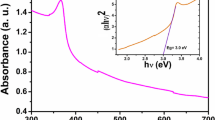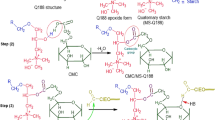Abstract
Functionalized textiles can be used in wound management to reduce the microbial burden in the wound area, to prevent wound infections, and to avoid cross-contamination between patients. In the present study, a comprehensive in vitro approach to enable the assessment of antibacterial activity of functionalized textiles and cytotoxicity of cyclodextrin (CD)-complexes with chlorhexidine diacetate (CHX), iodine (IOD), and polihexanide (PHMB) is suggested to evaluate their properties for supporting optimal conditions for wound healing. For all β-CD-antiseptic functionalized cotton samples a strong antibacterial effect on the Gram-positive bacteria Staphylococcus aureus and Staphylococcus epidermidis as well as on the Gram-negative bacteria Klebsiella pneumoniae and Escherichia coli was proven. In addition, β-CD-CHX and β-CD-PHMB were effective against the yeast Candida albicans. The growth of Pseudomonas aeruginosa could be reduced significantly by β-CD-IOD and β-CD-PHMB. The established comprehensive testing system for determination of biocompatibility on human HaCaT keratinocytes is suitable for obtaining robust data on cell viability, cytotoxicity and mode of cell death of the β-CD-antiseptic-complexes. The promising results of the high antimicrobial activity of these functionalized textiles show the high potential of such materials in medical applications.





Similar content being viewed by others
References
White RJ, Cutting K, Kingsley A. Topical antimicrobials in the control of wound bioburden. Ostomy Wound Manag. 2006;52(8):26–58.
McDonnell G, Russell AD. Antiseptics and disinfectants: activity, action, and resistance. Clin Microbiol Rev. 1999;12(1):147–79.
Wiegand C, Heinze T, Hipler UC. Comparative in vitro study on cytotoxicity, antimicrobial activity, and binding capacity for pathophysiological factors in chronic wounds of alginate and silver-containing alginate. Wound Repair Regen. 2009;17(4):511–21.
Ip M, Lui SL, Poon VK, Lung I, Burd A. Antimicrobial activities of silver dressings: an in vitro comparison. J Med Microbiol. 2006;55(Pt 1):59–63.
Hidalgo E, Bartolome R, Barroso C, Moreno A, Dominguez C. Silver nitrate: antimicrobial activity related to cytotoxicity in cultured human fibroblasts. Skin Pharmacol Appl. 1998;11(3):140–51.
Szejtli J. Introduction and general overview of cyclodextrin chemistry. Chem Rev. 1998;98(5):1743–54.
Del Valle EMM. Cyclodextrins and their uses: a review. Process Biochem. 2004;39(9):1033–46.
Loftsson T, Duchene D. Cyclodextrins and their pharmaceutical applications. Int J Pharm. 2007;329(1–2):1–11.
Stella VJ, He Q. Cyclodextrins. Toxicol Pathol. 2008;36(1):30–42.
Kurkov SV, Loftsson T. Cyclodextrins. Int J Pharm. 2013;453(1):167–80.
El Ghoul Y, Blanchemain N, Laurent T, Campagne C, El Achari A, Roudesli S, et al. Chemical, biological and microbiological evaluation of cyclodextrin finished polyamide inguinal meshes. Acta Biomater. 2008;4(5):1392–400.
Hoang Thi TH, Chai F, Lepretre S, Blanchemain N, Martel B, Siepmann F, et al. Bone implants modified with cyclodextrin: study of drug release in bulk fluid and into agarose gel. Int J Pharm. 2010;400(1–2):74–85.
Laurent T, Kacem I, Blanchemain N, Cazaux F, Neut C, Hildebrand HF, et al. Cyclodextrin and maltodextrin finishing of a polypropylene abdominal wall implant for the prolonged delivery of ciprofloxacin. Acta Biomater. 2011;7(8):3141–9.
Buschmann HJ. Applications in the food and textile industries. In: Schneider HJ, editor. Applications of supramolecular chemistry. Boca Raton, FL: CRC Press; 2012. p. 417–34.
Fouda MM, Knittel D, Hipler UC, Elsner P, Schollmeyer E. Antimycotic influence of beta-cyclodextrin complexes - in vitro measurements using laser nephelometry in microtiter plates. Int J Pharm. 2006;311(1–2):113–21.
Aleem O, Kuchekar B, Pore Y, Late S. Effect of beta-cyclodextrin and hydroxypropyl beta-cyclodextrin complexation on physicochemical properties and antimicrobial activity of cefdinir. J Pharmac Biomed. 2008;47(3):535–40.
Teixeira KI, Denadai AM, Sinisterra RD, Cortes ME. Cyclodextrin modulates the cytotoxic effects of chlorhexidine on microrganisms and cells in vitro. Drug Deliv. 2015;22(3):444–53.
Müller G, Kramer A. Biocompatibility index of antiseptic agents by parallel assessment of antimicrobial activity and cellular cytotoxicity. J Antimicrob Chemoth. 2008;61(6):1281–7.
Müller G, Koburger T, Jethon FUW, Kramer A. Vergleich der bakterioziden Wirksamkeit und In-vitro-Zytotoxizität von Lavasept® und Prontosan®. GMS Krankenhaushygiene interdisziplinar. 2007;2(2):Doc42.
Kloth LC, Berman JE, Laatsch LJ, Kirchner PA. Bactericidal and cytotoxic effects of chloramine-T on wound pathogens and human fibroblasts in vitro. Advances in Skin & Wound Care. 2007;20(6):331–45.
Wiegand C, Hipler UC. Evaluation of biocompatibility and cytotoxicity using keratinocyte and fibroblast cultures. Skin Pharmacol Physiol. 2009;22(2):74–82.
Lindner K, Szente L, Szejtli J. Food flavoring with β-cyclodextrin complexed flavour substances. Acta Alimentaria. 1981;10:175–86.
Wang T, Li B, Feng Y, Guo Q. Preparation, quantitative analysis and bacteriostasis of solid state iodine inclusion complex with b-cyclodextrin. J Incl Phenom Macrocycl Chem. 2011;69(1):255–62.
Reuscher H, Hirsenkorn R. Beta W7 MCT – New Ways in Surface Modification. Proc 8 Int Symp Cyclodextrins. 1996:553–558.
Ameri Dehabadi V, Buschmann HJ, Gutmann JS. Spectrophotometric estimation of the accessible inclusion sites of b-cyclodextrin fixed on cotton fabrics using phenolic dyestuffs. Anal Methods. 2014;6:3382–7.
Hipler UC, Schonfelder U, Hipler C, Elsner P. Influence of cyclodextrins on the proliferation of HaCaT keratinocytes in vitro. J Biomed Mater Res A. 2007;83(1):70–9.
Niles AL, Moravec RA, Riss TL. Multiplex caspase activity and cytotoxicity assays. Methods Mol Biol. 2008;414:151–62.
Niles AL, Moravec RA, Eric Hesselberth P, Scurria MA, Daily WJ, Riss TL. A homogeneous assay to measure live and dead cells in the same sample by detecting different protease markers. Anal Biochem. 2007;366(2):197–206.
Percival SL, Hill KE, Williams DW, Hooper SJ, Thomas DW, Costerton JW. A review of the scientific evidence for biofilms in wounds. Wound Repair Regen. 2012;20(5):647–57.
Cabrera CE, Gómez RF, Zuñiga AE, Corral RH, López B, Chávez M. Epidemiology of nosocomial bacteria -resistant to antimicrobials. Colomb Med. 2011;42(1):117–25.
Finger S, Wiegand C, Buschmann HJ, Hipler UC. Antimicrobial properties of cyclodextrin-antiseptics-complexes determined by microplate laser nephelometry and ATP bioluminescence assay. Int J Pharm. 2012;436(1–2):851–6.
Finger S, Wiegand C, Buschmann HJ, Hipler UC. Antibacterial properties of cyclodextrin-antiseptics-complexes determined by microplate laser nephelometry and ATP bioluminescence assay. Int J Pharm. 2013;452(1–2):188–93.
Wlodkowic D, Telford W, Skommer J, Darzynkiewicz Z. Apoptosis and beyond: cytometry in studies of programmed cell death. Methods Cell Biol. 2011;103:55–98.
Budihardjo I, Oliver H, Lutter M, Luo X, Wang X. Biochemical pathways of caspase activation during apoptosis. Annu Rev Cell Dev Biol. 1999;15:269–90.
Schonfelder U, Radestock A, Elsner P, Hipler UC. Cyclodextrin-induced apoptosis in human keratinocytes is caspase-8 dependent and accompanied by mitochondrial cytochrome c release. Exp Dermatol. 2006;15(11):883–90.
Wutzler P, Sauerbrei A, Klocking R, Brogmann B, Reimer K. Virucidal activity and cytotoxicity of the liposomal formulation of povidone-iodine. Antiviral Res. 2002;54(2):89–97.
Shrivastava A, Tiwari M, Sinha RA, Kumar A, Balapure AK, Bajpai VK, et al. Molecular iodine induces caspase-independent apoptosis in human breast carcinoma cells involving the mitochondria-mediated pathway. J Biol Chem. 2006;281(28):19762–71.
Liu XH, Chen GG, Vlantis AC, Tse GM, van Hasselt CA. Iodine induces apoptosis via regulating MAPKs-related p53, p21, and Bcl-xL in thyroid cancer cells. Mol Cell Endocrinol. 2010;320(1–2):128–35.
Vitale M, Di Matola T, D’Ascoli F, Salzano S, Bogazzi F, Fenzi G, et al. Iodide excess induces apoptosis in thyroid cells through a p53-independent mechanism involving oxidative stress. Endocrinology. 2000;141(2):598–605.
Faria G, Cardoso CRB, Larson RE, Silva JS, Rossi MA. Chlorhexidine-induced apoptosis or necrosis in L929 fibroblasts: a role for endoplasmic reticulum stress. Toxicol Appl Pharm. 2009;234(2):256–65.
Giannelli M, Chellini F, Margheri M, Tonelli P, Tani A. Effect of chlorhexidine digluconate on different cell types: a molecular and ultrastructural investigation. Toxicol In Vitro. 2008;22(2):308–17.
Rohner E, Seeger JB, Hoff P, Dahn-Wollenberg S, Perka C, Matziolis G. Toxicity of polyhexanide and hydrogen peroxide on human chondrocytes in vitro. Orthopedics. 2011;34(7):e290–4.
Creppy EE, Diallo A, Moukha S, Eklu-Gadegbeku C, Cros D. Study of epigenetic properties of Poly(HexaMethylene Biguanide) hydrochloride (PHMB). Int J Environ Res Public Health. 2014;11(8):8069–92.
Wiegand C, Abel M, Kramer A, Mueller G, Ruth P, Hipler UC. Proliferationsförderung und Biokompatibilität von Polihexanid. GMS Krankenhaushygiene Interdisziplinar. 2007;2(2):Doc43.
Niles AL, Moravec RA, Riss TL. In vitro viability and cytotoxicity testing and same-well multi-parametric combinations for high throughput screening. Curr Chem Genomics. 2009;3:33–41.
Acknowledgments
The authors would like to acknowledge support of this work by 15997BG grant from Arbeitsgemeinschaft Industrieller Forschungsvereinigungen (AIF).
Author information
Authors and Affiliations
Corresponding author
Ethics declarations
Conflict of interest
The authors declare that they have no conflict of interest.
Rights and permissions
About this article
Cite this article
Reddersen, K., Finger, S., Zieger, M. et al. Cytocompatibility testing of cyclodextrin-functionalized antimicrobial textiles—a comprehensive approach. J Mater Sci: Mater Med 27, 190 (2016). https://doi.org/10.1007/s10856-016-5804-4
Received:
Accepted:
Published:
DOI: https://doi.org/10.1007/s10856-016-5804-4




